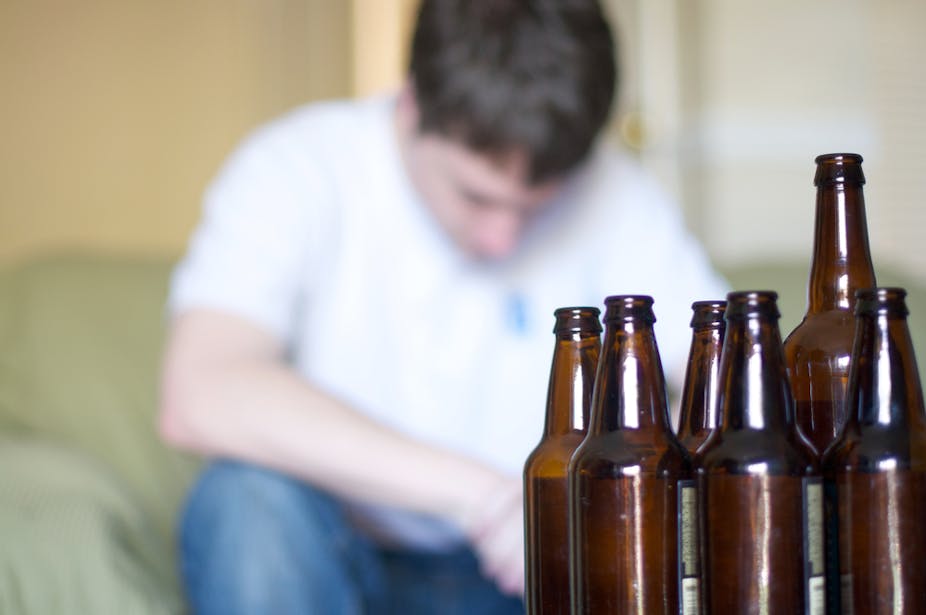A group of Australian doctors and academics has called on the Commonwealth government today to raise the legal drinking age to 21, in order to reduce the harms associated with early heavy drinking.
According to one recent report, almost two-thirds (63%) of drinkers aged 18 to 24 years say they drink alcohol to get drunk and one third (35%) report not being able to stop drinking once they’d started. Worryingly, more than a third (39%) are unable to remember what happened the night of a big drinking session.
We know that regulating access to alcohol significantly influences the risk of harm – recognition of this has underpinned Australia’s liquor licensing laws that prevent under 18s from purchasing or consuming alcohol on licensed premises.
But while there is strong evidence to support an increase in the legal drinking age, this is yet to translate to community support for such a change.
Harms of alcohol on young people
Young people are particularly vulnerable to the effects of heavy drinking. The harms include an increased risk of traffic accidents, injuries from violence and, some studies suggest, suicide. In Australia we have seen increasing rates of alcohol use cause hospitalisations among young Australians.
Evidence has also emerged over the past couple of years about the impact of alcohol on the developing brains of young people. These studies identify physical changes in the brain and evidence of impaired problem solving and other cognitive functioning. This, in turn, might influence the ability of the child to reach their full educational capacity.
A natural experiment
Quality research from the United States, New Zealand and Australia provides compelling evidence that if we increase the legal purchase age for alcohol, we will reduce alcohol-related problems among young people.
This evidence arises from changes in the 1970s and 1980s when many US and Australian states reduced their minimum legal purchase age to 18. More recently, New Zealand also reduced the minimum age from 20 to 18.

The Australian and the more recent New Zealand evidence give a consistent picture, even though the changes occurred two decades apart. Lowering the minimum legal purchase age was associated with an increase in road traffic accidents, and other harms, among young people.
Many US states reduced their drinking age from 21 to 18. However, concern about alcohol-related harm, especially on the roads, led to the National Minimum Drinking Age Act 1984, which tied federal funding for roads to the establishment of a minimum legal drinking age of 21.
A unique natural experiment allowed analysis of what happens when the drinking age goes down and then back up: alcohol consumption and traffic accidents among young people increased with more liberal legislation that lowered the drinking age, and then decreased with the more restrictive legislation that moved the legal drinking age back to 21. When the legal drinking age increased, the age of underage drinkers also increased.
The adverse effects of what young people do today can persist until later in life. Changes in the minimum legal purchase age in the US also allowed careful analysis of two large samples.
This analysis found that exposure to more a permissive legal purchase age – that is 18 versus 21 – was associated with an increased risk of “binge drinking” among young people, and this risk persisted into later adulthood.

The legal age debate
Combined, the evidence supports the calls to reconsider young people’s access to alcohol by increasing the minimum legal purchase age. But this is a contentious proposition. The arguments for maintaining the status quo include:
18 is recognised as the age at which young people enter adulthood and gain a number of responsibilities and freedoms, including the right to vote and to buy a drink
increasing the legal drinking age will not result in a decrease in alcohol-related harm among young people (“they’ll just get it anyway”)
in a country where individuals are legally obliged to vote at age 18, it is unlikely to gain political support.
The debate might be characterised as one about evidence, community expectations and political risk. The evidence about the benefits of increasing the minimum legal purchase age is strong – it does reduce access to alcohol and reduces harm. But good quality evidence does not always translate to community support or legislative change. While about half of Australians support increasing the drinking age, there is still much contention.
Some argue that before we consider changing the laws on age of access, we should focus on resourcing more effective enforcement of, and other strategies to ensure compliance with, the existing laws. These include not serving alcohol to under 18s, not serving intoxicated patrons, and continuing to focus on random breath testing reduces rates of young drink drivers and the associated trauma.

It’s important to remind ourselves of the range of other controls and responses that can reduce harm, including those that affect the availability and promotion of alcohol to young people. Some jurisdictions have recently adopted “secondary supply legislation” which determines that only a legal guardian has the right to decide whether or not to allow their child to drink in private settings, and it will be important to assess the impact of this response.
I’m not comfortable simply trying to cut through the debate about the legal drinking age by artlessly pointing to the evidence. But it is time to encourage an informed community debate about effective approaches, to acknowledge the evidence, and perhaps test some novel approaches, to address the well-founded concern about alcohol-related harm among young Australians.

